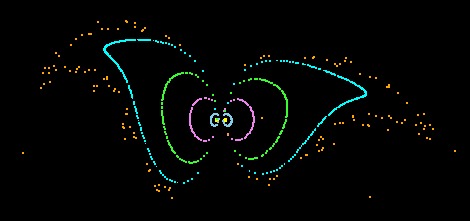 Taka Koyama had to modify the
Poincaré
section used for the Earth-Jupiter-Sun
system to make it useful here. In the old version, we took a snapshot
of the Earth's position every time it crossed between Jupiter and the
Sun. Of course, if the space-station, Moon, and Earth always form roughly
an equilateral triangle, the space station will never pass between the
Earth and Moon! Taka modified the program to take a snapshot whenever the
light body (space station here) passed through an axis 60 degrees behind
the line connecting the two heavy bodies (or more generally, an angle given
by theta_Poincare, the angular lag for the Poincare section).
Taka Koyama had to modify the
Poincaré
section used for the Earth-Jupiter-Sun
system to make it useful here. In the old version, we took a snapshot
of the Earth's position every time it crossed between Jupiter and the
Sun. Of course, if the space-station, Moon, and Earth always form roughly
an equilateral triangle, the space station will never pass between the
Earth and Moon! Taka modified the program to take a snapshot whenever the
light body (space station here) passed through an axis 60 degrees behind
the line connecting the two heavy bodies (or more generally, an angle given
by theta_Poincare, the angular lag for the Poincare section).
We've expanded the periodic orbit a lot, so instead of a dot (the intersection
of a closed curve with the Poincare cross-section) it now looks like two small
circles. (This happened because we input the initial conditions only to
a few decimal places.) Remember how much we've expanded the view: the whole
region around these orbits is extremely close to being periodic.
Click on areas near the left-hand Poincare section. (On the right, the
trajectories will look different. Remember the energy surface has two
sides, corresponding to the two solutions for v_perp for a given r_parallel
and v_parallel: I think clicking on the right gives the "other side" of
the energy surface.) Are there orbits starting near these circles which leave
the vicinity? The region between the two circles is forbidden by energy
conservation: the program finds a negative discriminant in the quadratic
formula conserving energy for finding v_perp, and writes VERBOTEN.
Near the forbidden region, it sure doesn't look stable!
Questions
Does "real" Lagrange point indeed lie between the two small circles?
Verify this by increasing the precision of the initial positions and
velocities for the space station. (In the configure menu, the space
station is called the Earth, the Moon is called Jupiter, and the Earth
is called Sun, because we're using a program which was intended to model
the Earth-Jupiter-Sun system...) Taka found a book to give the
equations for the coordinates: because the coordinates are centered at
the center-of-mass, it isn't just the Earth-Moon distance at angle pi/3.
Find out why L5 is thought to be stable. (I believe it involved
the eigenvalues of the linearization of the equations of motion about the
fixed-point in the rotating reference frame...) Can you use this method
to explain the quasiperiodic orbits (represented by the circles)? Should
some be periodic (and thus chaotic)?
Increasing or decreasing the radial velocity (vertical coordinate
on the display) seems to make for trajectories which leave the region.
It appears that L5 is not stable, from our program. What does the
linear stability analysis say about these trajectories?
Jupiter:
How to Get Jupiter
Jupiter is available
for Windows 95, Windows NT, Macintosh, and several Unix platforms
(the IBM RS6000, Sun Sparc, Dec Alpha (courtesy Kamal Bhattacharya),
Linux, and the PowerPC running AIX4.1).
The files are available without charge by anonymous FTP
(ftp.lassp.cornell.edu) or
via
the World Wide Web.
Last modified: May 19, 1996
James P. Sethna,
sethna@lassp.cornell.edu.
 Statistical Mechanics: Entropy, Order Parameters, and Complexity,
now available at
Oxford University Press
(USA,
Europe).
Statistical Mechanics: Entropy, Order Parameters, and Complexity,
now available at
Oxford University Press
(USA,
Europe).


![]() Statistical Mechanics: Entropy, Order Parameters, and Complexity,
now available at
Oxford University Press
(USA,
Europe).
Statistical Mechanics: Entropy, Order Parameters, and Complexity,
now available at
Oxford University Press
(USA,
Europe).
